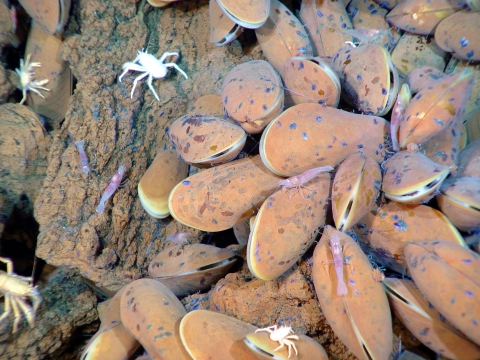Visit Us
The remote location and isolation of the Mariana Arc of Fire National Wildlife Refuge make it inaccessible to conduct on-site visits for educational or interpretative purposes. Thus, most educational and interpretative opportunities are necessarily delivered remotely through publications, off-site educational programs, displays, or other media, to inform and educate the public regarding the coral reef ecosystem and related marine resources and species of the monument and efforts to conserve them.
Location and Contact Information
About Us
The Mariana Arc of Fire National Wildlife Refuge isan arc of 18 undersea mud volcanoes and thermal vents. This arc of undersea mud volcanoes and thermal vents is part of a very geologically complex region including a subduction zone, back-arc basins, and active and potentially active island and submarine volcanoes. The area represents the only place on Earth with huge (largest = 31-mile diameter and >1-mile high) active mud volcanoes that release hydrogen. The Champagne vent, located at the Eifuku submarine volcano, produces almost pure liquid carbon dioxide, a phenomenon that has only been observed at one other site in the world. The molten Sulfur Cauldron (convecting pool of liquid sulfur) found at the Daikoku submarine volcano is unique; the only other known location of molten sulfur is on Io, a moon of Jupiter.
The refuge supports unusual life forms in some of the most extreme conditions imaginable. Here species survive amid hydrothermal vents that produce highly acidic and boiling water. The volcanic arc is known to host at least twenty vent fields that support a broad range of organisms, including gastropods, mussels, tubeworms, galatheid crabs, and shrimps. Unlike other reefs across the Pacific, the northernmost Mariana reefs provide unique volcanic habitats that support marine biological communities requiring basalt.
The vents release hydrogen sulfide and other minerals, which are consumed by the barophilic bacteria, which are then consumed by other microorganisms, which are in turn, consumed by the fish, and so on. The temperature around the vents can reach up to 300° Celsius (572° Fahrenheit). Creatures from the deep show an incredible resistance to temperature extremes by having different proteins which are adapted for life under these conditions; allowing the animals to eat, process food, and reproduce. One animal that thrives near hydrothermal vents is the Bythograea thermydron or "vent crab."
Maug Crater represents one of only a handful of places on Earth where photosynthesis and chemosynthetic communities of life are known to come together. The caldera is some 1.5 miles wide and 820 feet deep, an unusual depth for lagoons. The lava dome in the center of the crater rises to within 65 feet of the surface. Hydrothermal vents at about 475 feet in depth along the northeast side of the dome spew acidic water at scalding temperatures near the coral reef that quickly ascends to the sea surface. Thus, coral reefs and microbial mats are spared much of the impact of these plumes and are growing nearby, complete with thriving tropical fish.
What We Do
The Mariana Arc of Fire National Wildlife Refuge contains unique geological features found nowhere else in the world, including the largest active mud volcanoes, vents expelling almost pure liquid carbon dioxide, a pool of liquid sulfur, and one of only a few places in the world where photosynthetic and chemosynthetic communities of life coexist.
Our Species
In areas of this refuge, chemosynthetic and photosynthetic organisms co-exist side-by-side, creating unique biological hotspots of diversity. Here species also survive in the midst of hydrothermal vents that produce highly acidic and boiling chemical soup. The temperature around the vents can reach up to 572° F.
Get Involved
The remote location and isolation of the Mariana Arc of Fire National Wildlife Refuge make it inaccessible to conduct on-site visits for educational or interpretative purposes. Thus, most educational and interpretative opportunities are necessarily delivered remotely through publications, off-site educational programs, displays, or other media, to inform and educate the public regarding the coral reef ecosystem and related marine resources and species of the monument and efforts to conserve them. For more information on these programs in Saipan, contact Park Ranger Jihan Younis at (670) 234-7207 ext. 4001.
Projects and Research
The 18 submerged volcanic features along the Mariana Ridge and their surrounding submerged lands within a circle with a 1 nautical mile radius were designated as the volcanic unit/Arc of Fire Refuge of the Marianas Trench Marine National Monument on January 6, 2009, through Presidential Proclamation 8335. These submerged lands are managed as a unit of the National Wildlife Refuge System in accordance with Secretary’s Order 3284, which created the refuge on January 16, 2009. All of these features are within the U.S. Exclusive Economic Zone surrounding the Mariana Islands.
Programs for monitoring and enforcement necessary to ensure that scientific exploration and research, tourism, and recreational and commercial activities do not degrade the Refuge's coral reef ecosystem or related marine resources or species or diminish the Refuge's natural character.



